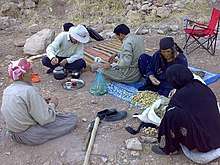Pendro
Pendro or Pendru (Kurdish: پێندرۆ, Pêndro)[1][2] is a Kurdish village in Kurdistan Region, located in Erbil Province, close to the border with Turkey, it is located approximately 15–18 km to the north from Barzan, of population over 2540 people and located in central Muzuri Bala one of the seven tribes of Barzan. It lies in a valley surrounded by low peaks and mount Butin about 4 km northeast of Pendro and also the canyon of Sardav is about fifteen minutes walk from the north end of the village. The villages of Banan and Shive to the north, Derek to the northeast, Edlbey and Zet to the east, Selke, Stope and Guiza Walati to the south, Binavye and Navkorka to the west, Dezo and Spindare to the northwest. The area of Pendro covers over 10 km2 (4 sq mi). The terrain is highly mountainous, lying within the Zagros; less than 10% of the Pendro is below 1,225 m (4,019 ft), and its highest point is 2,534 m (8,314 ft). All population speaks local Bahdini dialects of Kurdish as their native language, and Central Kurdish in its standard form is the Kurdistan's official language.[3]
Pendro Kurdish: Pêndro ,پێندرۆ | |
|---|---|
Village | |
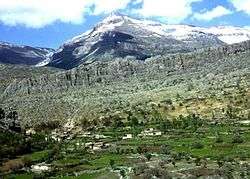 Pendro and Mount Butin (1968) | |
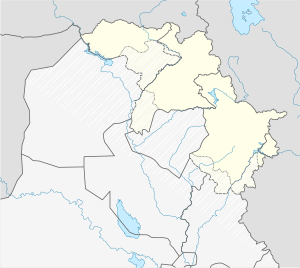 Pendro  Pendro | |
| Coordinates: 37°03′42″N 44°06′20″E | |
| Country | |
| Autonomous region | |
| Province | Erbil |
| District | Mergasor |
| Subdistrict | Shirwan Mezin |
| Elevation | 1,325 m (4,347 ft) |
| Population (2017) | |
| • Total | 2,547 |
| Demonym(s) | Pendroi |
| Time zone | UTC+3 |
| Area code(s) | 0750 |
History
Pendro's history stretches back to at least the era of Badinan Emirate rule in Amadiya, which ended conclusively in 1843.[4] Pendro is inhabited by the Muzuri clan for hundreds of years. Muzuri is one of the oldest Kurdish tribes in Kurdistan. The tribe first time mentioned by Sharafkhan Bidlisi in his book Sharafnama in 1597.[5] Muzuri tribe mentioned by Evliya Çelebi in his travelogue called the Seyahatname ("Book of Travel") in 1638,[6] and mentioned by Mark Sykes in 1909, Also mentioned by the Kurdish historian Zaki in his book (Kurd and Kurdistan) in 1931.[7] The terrain, wooded and mountainous, favored the Kurdish-nationalists and Social movement. Throughout history, the region had been invaded many times by external powers. Pendro and other villages in region were enemy's biggest geopolitical threat. Many times the villagers were forced to leave and destroyed their villages, Kurdish enemy did this because too many villagers had rebelled and were fighting for Kurdish independence.[8] Many Pendroi joined the first Barzan Revolt which ended in 1932 and Shaykh Ahmed Barzani was later forced to flee to Turkey with 400 Barzani families, this number includes 31 Pendroi families.[9] One decade later in 1943 Mustafa Barzani was escape from his exile in Sulaymaniyah, he returned to Barzan and he had visited a number of villages in the region and a number of village men soon joined him and captured and disarmed the local police. A bloody clash between the Barzani and Military intelligence officers in Pendro, this clash that led to the death of the three Iraqi Military intelligence officers, that was the beginning of 1943 Barzani revolt. Occupation of Barzan on 7 October 1945 by Iraq, forced Barzani to order his forces to retreat from the region and cross into Iranian Kurdistan with nearly three thousands Barzani, 165 of them came from Pendro. And later settled and join establishing the Republic of Mahabad. After Mahabad Republic was overrun by Iran's army, Barzani and his 500 followers took refuge in Soviet, including 19 Pendroi.[10] Over 150 Pendroi participated in Aylul Revolution and Gulan Revolution. After Algiers Accord over sixty thousands Kurdish, including 116 Pendroy families forced to become refugees, fleeing mostly to neighbouring Iran. On 25 June 1978 Iraqi Army removed all villagers nearer the border to different camps in Erbil Province and destroyed the villages, all Pendroi settled in Bahirka camp, the region entirely destroyed and left uninhabitable.[11] Genocide against the Barzani Kurds by Iraqi regime in 1983, the killing of the 8,000 Barzani, 16 victims were from Pendro.[12][13][14] During the Kurdish Rebellion some Pendroi families went back to Pendro and rebuilt new village in the north, toward to the mount Butin an area of the land called "Mlane", once again their village destroyed by Iraqi regime in 1987 and villagers forced to become refugees in Iran.[15] In 1991, after Kurdish Uprisings, people came back to the village and it was rebuilt in 1994 by one of the British organizations. The new village rebuilt about 1.5 kilometres (1 mi) west of Pendro a region of the land called "Chema". But two years later the village destroyed during the PKK-Turkish conflict.[16]
Geography
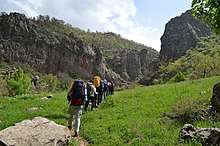
Pendro lies at an altitude of 1,325 metres (4,347 ft) above sea level and covers an area over 10.0 square kilometres (3.9 sq mi). It is located in northern Kurdistan. The terrain mostly consists of mountains and hills, with very little moderately sloping plains. The lowest point is the Chema Stream, at 1174 metres, and the highest is Mount Butin, at 2,534 metres, in the Chema, just west of the confluence of the many Stream. Mountain ranges in the proximity of the village are Butin and Kerye Spindare, more to the south are Misek and Kore Hure. Pendro has neither rivers nor lakes. In terms of land boundaries, Pendro borders Edlbey, Zet, Banan, Shive, Dezo, Spindare, Navkorka, Binavye, Stope, Selke, Guiza Walati and Derek for over 50 kilometres (31 mi). The nearest major towns are Sherwan Mezin, 14 kilometres (9 mi) away to the south-east, Barzan, 18 kilometres (11 mi) away to the south and capital Erbil, 172 kilometres (107 mi) to the south (by road). The village-wide common lands called: Sebaski, Gure, Chema, Mlane, Butine, Elye, leri and Ser xingel. Pendro has so many springs the main springs are Kanya Gundi, Kanya Serderave, Kani Jefre, Kanya Mlane, Kanya Butine, Kanya Helara and Kanya Mira.
Bordering villages
Climate
Pendro's clamate is Hot/warm-summer humid continental (Dsa) according to Köppen climate classification, Weather in region is moderate especially in winter which is very cold and rainy (more than 1,500 mm (59 in) in some years) in addition to the fall of 150 cm (59 in) of snow annually. January is the wettest month.[17]
| Climate data for Pendro (2009–2016) | |||||||||||||
|---|---|---|---|---|---|---|---|---|---|---|---|---|---|
| Month | Jan | Feb | Mar | Apr | May | Jun | Jul | Aug | Sep | Oct | Nov | Dec | Year |
| Record high °C (°F) | 13.0 (55.4) |
17.0 (62.6) |
20.0 (68.0) |
27.0 (80.6) |
33.0 (91.4) |
39.0 (102.2) |
44.0 (111.2) |
44.0 (111.2) |
40.0 (104.0) |
31.0 (87.8) |
22.0 (71.6) |
14.0 (57.2) |
44.0 (111.2) |
| Average high °C (°F) | 9.5 (49.1) |
12.2 (54.0) |
16.2 (61.2) |
23.0 (73.4) |
29.6 (85.3) |
36.7 (98.1) |
41.0 (105.8) |
40.7 (105.3) |
35.2 (95.4) |
27.5 (81.5) |
18.8 (65.8) |
12.2 (54.0) |
25.2 (77.4) |
| Daily mean °C (°F) | 6.1 (43.0) |
8.5 (47.3) |
11.7 (53.1) |
18.0 (64.4) |
25.6 (78.1) |
31.7 (89.1) |
35.3 (95.5) |
34.7 (94.5) |
29.1 (84.4) |
22.3 (72.1) |
14.6 (58.3) |
7.1 (44.8) |
20.4 (68.7) |
| Average low °C (°F) | 1.8 (35.2) |
3.2 (37.8) |
5.0 (41.0) |
9.5 (49.1) |
15.6 (60.1) |
21.2 (70.2) |
23.6 (74.5) |
22.2 (72.0) |
17.3 (63.1) |
13.5 (56.3) |
7.6 (45.7) |
3.5 (38.3) |
12.0 (53.6) |
| Record low °C (°F) | −9.0 (15.8) |
−12.0 (10.4) |
−2 (28) |
10.0 (50.0) |
14 (57) |
20.0 (68.0) |
22.0 (71.6) |
20.0 (68.0) |
14.0 (57.2) |
9.0 (48.2) |
−1.0 (30.2) |
−5.0 (23.0) |
−12.0 (10.4) |
| Average rainfall mm (inches) | 155.1 (6.11) |
91.0 (3.58) |
143.6 (5.65) |
89.1 (3.51) |
51.0 (2.01) |
2.9 (0.11) |
1.5 (0.06) |
1.3 (0.05) |
3.9 (0.15) |
53.9 (2.12) |
85.0 (3.35) |
141.6 (5.57) |
819.9 (32.27) |
| Average snowfall cm (inches) | 12.0 (4.7) |
34.3 (13.5) |
16.9 (6.7) |
1.0 (0.4) |
0.0 (0.0) |
0.0 (0.0) |
0.0 (0.0) |
0.0 (0.0) |
0.0 (0.0) |
0.0 (0.0) |
0.0 (0.0) |
7.2 (2.8) |
71.4 (28.1) |
| Average rainy days | 12.3 | 10.5 | 14.8 | 12.5 | 10.7 | 3.7 | 0.5 | 1.5 | 2.3 | 8.5 | 9.8 | 11.1 | 98.2 |
| Average snowy days | 2.2 | 3.6 | 5.5 | 0.9 | 0.0 | 0.0 | 0.0 | 0.0 | 0.0 | 0.0 | 0.0 | 1.7 | 13.9 |
| Average relative humidity (%) | 64.8 | 60.8 | 58.8 | 51.5 | 37.3 | 22.8 | 18.6 | 18.7 | 24.7 | 36.8 | 47.8 | 59.2 | 41.8 |
| Source 1: Worldweatheronline | |||||||||||||
| Source 2: Accuweather | |||||||||||||
Demographics
People
Pendro is the 3rd-largest village in Muzuri tribe by population, in the 2017 Census conducted by Muhammadali Sa‘id Pendroi,[18] the Village of Pendro recorded a population of 2547, the census revealed the following numbers: 1290 females (50.65%), 1257 males (49.35%). More than half of them living in Bahirka since 1978.
| Rank | Place | Households |
|---|---|---|
| 1 | Bahirka | 342 |
| 2 | Erbil | 67 |
| 3 | Pirmam | 59 |
| 4 | Soran | 46 |
| 5 | Barzan | 18 |
| 6 | Dohuk | 16 |
| 7 | Rezan | 11 |
| 8 | Ble | 9 |
| 9 | Syrye | 5 |
| 10 | Zakho | 1 |
| 11 | Selke | 1 |
| 12 | Gureto | 1 |
| 13 | Shaneder | 1 |
| 14 | Shakholan | 1 |
| Total | 14 | 578 |
| Rank | Country | Households |
|---|---|---|
| 1 | United States | 10 |
| 2 | Germany | 8 |
| 3 | Sweden | 7 |
| 4 | Russia | 5 |
| 5 | Denmark | 5 |
| 6 | Netherlands | 4 |
| 7 | UK | 3 |
| 8 | Canada | 2 |
| 9 | Australia | 1 |
| Total | 9 | 45 |
Education
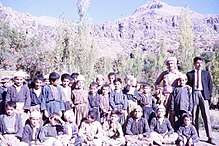
According to a 2017 census by Muhammadali Sa‘id Pendroi,[19] Pendro is one of the most educated villages in the Mergasor District. With over 50 percent of Pendroi adults having attained at least an undergraduate college or university degree.
| Rank | Stage | Male | Female | Total |
|---|---|---|---|---|
| 1 | First Grade to Twelfth Grade | 343 | 310 | 653 |
| 2 | University | 49 | 52 | 101 |
| 3 | Educational Institutions | 16 | 17 | 33 |
| 4 | Doctoral | 4 | 1 | 5 |
| 5 | Master | 1 | 1 | 2 |
| Total | 5 | 423 | 371 | 794 |
| Rank | Degree & Diploma | Male | Female | Total |
|---|---|---|---|---|
| 1 | University | 131 | 98 | 229 |
| 2 | Institution | 65 | 77 | 142 |
| 3 | Master | 14 | 4 | 18 |
| 4 | Doctoral | 4 | 2 | 6 |
| 5 | High Diploma | 2 | 0 | 2 |
| Total | 5 | 216 | 181 | 397 |
Wildlife
Environmental protection in Pendro and other parts of Barzani tribes began during the leadership of Khudan, he has banned the cutting of trees and hunting wild animals, especially wild goat and more progressive environmental protection had it start in the 1990s.
Flora
Pendro has a hundreds species of plants,[20] some of species are introduced and non-native. More than 70% the area of the Pendro is forested, with stands of Plane tree, Oak, Quercus infectoria, Chestnut, Pistacia atlantica, Almond, Walnut, Fig, Vitis, Pear, Morus nigra, Apricot, Plum, Apple, Pomegranate, Peach, Quince, Sumac and other valuable trees. Mountain herbs such as Mushroom, Ferulago, Fennel, Wild leek, Carduus nutans, Arum, Allium, Rheum ribes and many other mountain herbs. In flowers include Narcissus, Fritillaria imperialis, Papaver rhoeas and other beautiful flowers.[21]
Fauna
Mammals
Animals that inhabit around the Pendro include Brown bear, Syrian brown bear, Squirrel, Wild goat, Boar, Wolf, Hyena, Golden jackal, Mouflon, Badger, Crested porcupine, Marbled polecat, Fox, Hare, Hedgehog.[22][23] Felidae in this family include Wild cat, Caracal.
Birds
Tens of thousands birds from many species pass through Pendro and surrounding villages during the bi-annual migration season, from Caucasus and West Asia to south Iraq and south-east Iran in the winter, and back in the spring. Entire region is the stopover point for thousands birds migrating from Caucasus to Gulf and migrating Cranes some time take a pause because of bad weather as they travel between breeding and wintering grounds. These are some names of bird species in Pendro and surrounding areas.[24]
Chukar, Partridge, Francolin, Quail, Crane, Black kite, Vulture, Eagle, Harrier, Common buzzard, Buzzard, Eagle, Golden eagle, Kestrel, Falcon, Egret, Heron, Stork, Teal, Mallard, Curlew, Tern, Rock pigeon, Dove, Pigeon, Cuckoo, Owl, Eagle-owl, Brown fish owl, Little owl, Nightjar, Alpine swift, Swift, Kingfisher, European bee-eater, Bee-Eater, Hoopoe, Syrian woodpecker, Woodpecker, ( eight species of Lark), Wren, Accentor, Blackbird, Thrush, Song thrush, ( over four species of Warbler), European robin, Robin, White-throated robin, Blue tit, Great tit, Tit, Redstart, Rock nuthatch, Persian nuthatch, Shrike, Masked shrike, Eurasian jay, Magpie, Raven, Crow, Starling, Yellowhammer, Pine, ( at least over six species of Bunting bird), Chaffinch, Brambling, Goldfinch, Twite, Serin, Sparrow, there are over 30 species of Sparrow worldwide and eight species which occur in areas.
Reptiles and Others
The following are some of the reptiles of Pendro, primarily covering the region in northeast Kurdistan. Macrovipera, Dolichophis. Kurdistan viper, Testudo, Spur, Ophisops, Gecko, House gecko, some other species of Snake, lizard and Turtle occur in region. Amphibians in this class, Frog, Marsh frog and other amphibians. Pendro has thousands of Invertebrates and Invasive species.[25][26]
References
- "Balafirên Tirkiyeyê êrişî kampên PKKê kirin". Rûdaw (in Kurdish). 23 September 2015. Retrieved 19 December 2019.
- "گالەری - کوێستانی پێندرۆ" (in Kurdish). Rûdaw. Retrieved 19 December 2019.
- "Kurdistan's official language: Constitution of the Iraqi Kurdistan Region". unpo.org.
- Ceylan, Ebubekir. Ottoman Origins of Modern Iraq: Political Reform, Modernization and Development in the Nineteenth Century Middle East. I.B.Tauris. pp. 50, 51. ISBN 978-0-85772-041-2.
- Bidlīsī, Sharaf Khān; Izady, Mehrdad R. (2005). The Sharafnam̂a, or, The history of the Kurdish nation, 1597. Mazda. ISBN 978-1-56859-074-5.
- Çelebi, Evliya (1991). The Intimate Life of an Ottoman Statesman, Melek Ahmed Pasha (1588–1662): As Portrayed in Evliya Celebi's Book of Travels (Seyahat-name). SUNY Press. p. 175. ISBN 978-0-7914-0640-3.
- Bayg, Muhammad Amin Zaki (2002). Zubah-i Tarikh-i Kurd va Kurdistan. Intisharat-i Tus. ISBN 9789643155650.
- "Xebat Newspaper". Xebat.net. Archived from the original on 2017-07-28. Retrieved 2017-05-14.
- "The first of the major Barzani revolts" (PDF). historyofkurd.com. 2016. Archived (PDF) from the original on 2017-07-28. Retrieved 2017-05-14.
- Barzani, Massoud (2003). Mustafa Barzani and the Kurdish Liberation Movement. Palgrave Macmillan. p. 65. ISBN 978-0-312-29316-1.
- "WHAT HAPPENED IN THE KURDISH GENOCIDE". uk.gov.krd. Archived from the original on 2016-03-04.
- "FROM BLUEPRINT TO GENOCIDE?" (PDF). drmohammedihsan.com. 2014. Archived from the original (PDF) on 2017-01-09. Retrieved 2017-05-14.
- Agency, krg.org. "Iraqi tribunal rules Barzani killings in 1983 were genocide". ekurd.net. Archived from the original on 2018-08-10. Retrieved 2018-09-07.
- "Various waves of Kurdish genocide". uk.gov.krd. Archived from the original on 2017-09-01. Retrieved 2017-05-14.
- "Pendro Etymology". ekurds. Archived from the original on 2017-04-17. Retrieved 2017-05-17.
- Nawzad Hluri. "زیانهكانی بۆردمانی شهوی رابردووی فڕۆكه توركییهكان". wishe. Archived from the original on 2018-08-10. Retrieved 2017-05-14.
- "Weather in Pendro, Arbil". us.worldweatheronline.com.
- "Muhamadali Sayid ,2017 Census". www.facebook.com.
- "Pendro village". www.facebook.com.
- "Home | Kurd Flora". www.kurdflora.com. Archived from the original on 2018-09-28. Retrieved 2018-12-01.
- "Survey and Identification of Mushrooms in Erbil Governorate (PDF Download Available)". ResearchGate. Archived from the original on 2018-09-28. Retrieved 2017-05-07.
- Farhadinia, Mohammad Sadegh; Valizadegan, Negin (26 January 2015). "A preliminary baseline status of the Syrian Brown Bear Ursus arctos syriacus (Mammalia: Carnivora: Ursidae) in Golestanak, Northern Iran". Journal of Threatened Taxa. pp. 6796–6799. Archived from the original on 14 August 2015.
- "NMNH Department of Systematic Biology, Division of Mammals - Mammal Species of the World Home Page". 27 April 2007. Archived from the original on 27 April 2007.
- "Iraq bird checklist". avibase.bsc-eoc.org. Archived from the original on 2012-09-22. Retrieved 2017-05-04.
- "Venomous Snakes In Iraq". www.reptilesmagazine.com. Archived from the original on 2017-05-22. Retrieved 2017-05-08.
- "Iraq Check List". iNaturalist.org. Archived from the original on 2018-10-30. Retrieved 2018-03-22.
